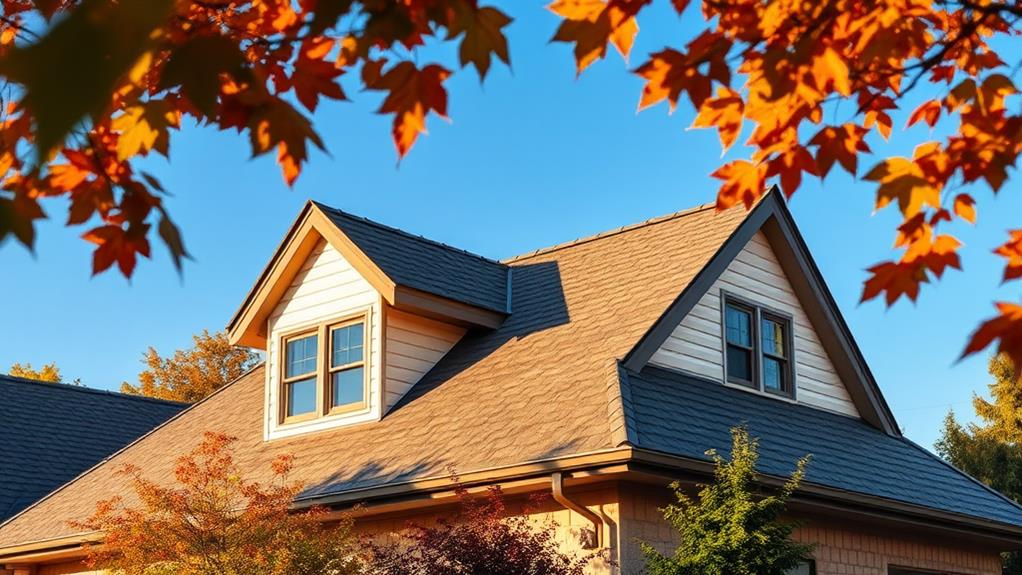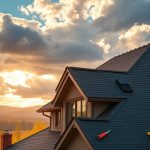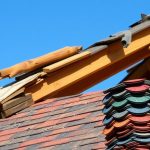Common residential roof problems include shingle damage caused by weather events or age, leading to water infiltration and potential structural harm. Inadequate ventilation can cause heat and moisture buildup, resulting in mold growth and weakened roof materials. Weather-related wear, such as UV exposure, heavy winds, and ice dam formation, further exacerbates these issues, contributing to premature shingle aging and wood rot. Routine inspection and maintenance, including clearing gutters, securing loose items, and professional assessments, are essential in preventing these problems. Addressing these concerns promptly and efficiently guarantees prolonged roof integrity and safeguards the home's structural soundness more thoroughly.
Roofing Highlights
- Shingle damage from age, weather, or debris can cause water infiltration and structural issues.
- Poor roof ventilation leads to moisture buildup, promoting mold and structural weakening.
- Weather-related wear, such as UV exposure and ice dams, damages shingles and underlayment.
- Improper roof installation techniques can result in loose or missing shingles.
- Storms and high winds can loosen or remove shingles, compromising roof integrity.
Types of Roof Issues

Residential roofing systems are susceptible to a range of issues that can drastically impact their integrity and functionality. Shingle damage, often a precursor to leaks, is commonly caused by various factors including age, weather events, and fallen debris. Regular maintenance and inspections by experienced inspectors, who guarantee top-notch quality, are essential to prolonging the life of your roof.
Additionally, inadequate roof ventilation can exacerbate moisture buildup and temperature imbalances, while persistent exposure to harsh weather conditions leads to progressive wear and tear, necessitating timely inspections and maintenance to address these problems effectively.
Shingle Damage Causes Leaks
Shingle damage is a common roofing issue that can lead to significant water infiltration, resulting in leaks that compromise the integrity of a home. When shingles are damaged, whether due to age, weather conditions, or improper installation, they can become ineffective barriers, allowing water to penetrate the underlying roofing materials. This infiltration can result in a host of problems, from structural damage to interior water stains, mold growth, and potential decreases in property value.
Shingles can suffer damage in myriad ways, each with their distinctive consequences. High winds have the capacity to dislodge or even remove shingles entirely, exposing the roof's vulnerable layers. Similarly, hail impact can create cracks or bruises in shingles, leading to faster deterioration. Aside from weather-related causes, poor installation practices can also render shingles ineffective from the outset. Improper nailing techniques, for example, may cause shingles to loosen, paving the way for potential leaks.
For homeowners, maintaining a robust roof is pivotal not only for structural protection but also for nurturing a sense of safety and belonging within the household. Regular inspections and prompt repairs, conducted by skilled professionals, can mitigate the risks associated with shingle damage—enabling peace of mind and long-term home stability.
Poor Roof Ventilation Effects
Inadequate roof ventilation often leads to a multitude of issues that can compromise both the performance and longevity of a roofing system. Poor ventilation creates an environment within the attic space where heat and moisture accumulate, conditions that can expedite structural damage.
This unnecessary accumulation of heat can warp and weaken roof decking and lead to asphalt shingles becoming prematurely brittle, ultimately reducing their lifespan. Over time, trapped moisture can also foster mold growth, which not only affects indoor air quality but can also cause wooden components to rot, gradually undermining the roof's foundational integrity.
Moreover, ineffective ventilation often results in uneven temperatures across roofing materials, leading to thermal shock. This condition is characterized by rapid expansion and contraction cycles, which can hasten the degradation of roof components. In colder climates, poor ventilation can exacerbate the formation of ice dams on rooftops. These ice formations can promote water infiltration beneath roofing materials, causing leaks and potential interior damage.
Maintaining adequate airflow by ensuring attics are equipped with functional intake and exhaust vents is crucial. Homeowners are encouraged to engage with roofing professionals to inspect and address any deficiencies in ventilation, thereby safeguarding their home investment.
Weather-Related Wear Issues
Besides ventilation issues, weather-related wear poses significant challenges to roofing systems. This type of wear is often underestimated, yet it plays a pivotal role in a roof's longevity and performance. Weather elements like rain, wind, snow, and sunlight continually impact the structural integrity of roofing materials. For instance, prolonged exposure to ultraviolet rays can cause shingles to crack and lose granules, leading to reduced protection against the elements. Similarly, heavy winds have the capacity to loosen shingles, permitting water infiltration that can compromise the roof's underlayment and insulation.
When a community faces seasonal changes, ice dam formation can further exacerbate roof wear. As snow melts, water can re-freeze at the edge of the roof, creating barriers that prevent proper drainage. This condition can lead to water seeping under shingles and damaging the internal structure of the roofing system. In coastal areas dominated by humidity and frequent storms, persistent moisture accelerates mold growth and promotes rusting of metal components.
It is essential for homeowners to engage with knowledgeable roofing professionals to conduct regular inspections. Routine maintenance guarantees that weather-related damage is identified early and remedied, thereby preserving the structural integrity and aesthetic appeal of their homes.
Benefits

Addressing residential roof problems not only mitigates existing issues but also offers numerous benefits that extend beyond simple repairs. By enhancing energy efficiency, an upgraded roof can contribute to lower utility bills, while simultaneously boosting the property's market value.
Additionally, improving the roof's condition enhances curb appeal, making the home more attractive to potential buyers and elevating its overall aesthetic presence in the neighborhood. It's important to choose a roofing contractor who serves your area, such as ARCM Roofing, to guarantee the project is carried out professionally and effectively.
Energy Efficiency Improvements
Any homeowner considering upgrades to their residence understands the significant impact that energy efficiency improvements can deliver. By integrating modern materials and technologies, residential roofs can transform into energy-saving assets. One such advancement is the use of cool roofing materials, which possess reflective properties designed to minimize heat absorption. This, in turn, relieves the burden on air conditioning systems, consequently reducing energy consumption and utility expenses.
Moreover, enhancing insulation under the roofing structure is a crucial strategy. Improved insulation reduces heat transfer between the building and external environment, ensuring ideal indoor temperatures regardless of weather extremes. By preventing heat loss during winters and keeping interiors cooler in summers, residents experience greater comfort, fostering a bond with their living spaces.
The inclusion of solar panels into roofing systems also represents a formidable shift towards sustainability. Not only do they provide an alternative power source, decreasing reliance on traditional energy supplies, but they also contribute to a homeowner's commitment to environmental stewardship.
These solutions integrate seamlessly, supporting a community's collective endeavor toward energy conservation. Energy efficiency improvements not only benefit individual households but also resonate throughout neighborhoods, fostering a shared sense of responsibility and connection.
Increased Property Value
Beyond the obvious benefits of energy efficiency, implementing improvements to residential roofs can substantially enhance property value. The state of a roof plays a pivotal role in a property's structural integrity and market desirability, making it an essential factor for potential buyers. A well-maintained or upgraded roof can serve as a promising indicator of overall home upkeep, thereby positioning the property as a wise investment.
As prospective homeowners prioritize security and minimal future maintenance, properties with robust roofing systems typically command higher valuations.
Investing in quality roofing materials and upgrades is not merely about maintenance; it reflects a commitment to sustainability and long-term home care. High-performance roofing materials such as slate, metal, or advanced composites contribute to the property's longevity, making it appealing to eco-conscious buyers. These materials often come with warranties that further assure their durability and the investor's peace of mind.
Moreover, roof improvements like updated insulation and ventilation systems help preserve the interior from elemental wear, directly influencing the home's interior condition. This not only raises living comfort but also diminishes future remediation costs for potential buyers, establishing the property as a sound and attractive purchase opportunity.
Enhanced Curb Appeal
A contextually relevant advantage of residential roof improvements is the enhanced curb appeal that they provide. This enhancement is not merely superficial but serves as an indication of the quality and care invested in one's home, aligning with the communal aspiration for an inviting and well-maintained neighborhood. A home's roof, often the most pronounced feature of its exterior, plays a pivotal role in shaping perceptions of the property. By addressing common roof problems with high-quality materials and expert craftsmanship, homeowners can transform their roofs into standout features that meaningfully uplift the home's overall aesthetic.
Moreover, a visually appealing roof can serve as a unifying element that fosters a sense of communal pride among neighbors, creating a cohesive and harmonious streetscape. The choice of hues, textures, and architectural styles can be tailored to resonate with the existing design language of surrounding homes, ensuring that the improved roof does not only enhance the individual property but also contributes positively to the visual appeal of the entire neighborhood. In a community where residents value belonging and mutual respect, upgrading a roof becomes more than an individual investment; it becomes a commitment to enhancing shared spaces and collective identity.
Seasonal Maintenance Tips Included

Proper seasonal maintenance is essential for extending the lifespan of your residential roof and preventing costly repairs. Each season presents unique challenges, from winterizing your roof to protect against harsh weather, to conducting essential spring cleaning that guarantees debris removal, and finally, preparing for summer storms that can greatly impact the integrity of your roofing structure. The following table outlines specific tasks for each season to aid homeowners in maintaining their roof's durability and performance.
| Season | Key Maintenance Task |
|---|---|
| Winter | Reinforce insulation and check for ice dams. |
| Spring | Clear gutters and inspect for water damage. |
| Summer | Secure loose shingles and trim overhanging branches. |
Winterizing Your Roof
As the frost begins to form its delicate tracery on trees and rooftops, preparing your home for the winter months becomes vital to prevent costly damage. Confirming that your roof is well-maintained during this time can safeguard your home against the harsh elements.
Begin by thoroughly inspecting your roof for damaged or missing shingles, as these can allow water infiltration, leading to leaks and structural damage. Pay attention to any signs of wear such as curling or blistering shingles, and address them promptly to maintain the integrity of your roof.
Clearing your roof and gutters of debris, especially leaves and twigs, is imperative. Blockages in gutters can cause water to back up and seep under the roofing, leading to ice dams and subsequent damage. Cleaning ensures proper water flow and reduces weight from ice and snow accumulation.
Another key consideration is confirming that your roof's flashing—metal pieces designed to direct water away from areas such as chimneys and vents—is intact and secure. Damaged flashing can lead to water penetration during winter. By caring for these essential maintenance tasks, you'll foster a sense of security and belonging, knowing your home is protected against winter's chilling grasp.
Spring Cleaning Essentials
Spring ushers in the perfect opportunity for homeowners to assess and rejuvenate their properties after the heavy toll of winter. The empowering warmth of spring calls for attentive examination of your residential roof.
Begin by removing debris such as leaves and branches that may have accumulated in gutters and on shingles. This task not only prevents water buildup and damage but also promotes a healthy drainage system.
Meticulously inspect for signs of deterioration, including cracked, loose, or missing shingles which could illustrate underlying structural concerns. Confirm the integrity of flashing around chimneys, vents, and skylights to avert potential leaks, encompassing all facets in a thorough examination.
Particularly pertinent is the inspection of attic ventilation and insulation, as these elements play pivotal roles in maintaining energy efficiency and minimizing moisture-related issues. Engage a professional when in doubt, as they bring expert knowledge to spot unseen complications and deliver complete maintenance.
Moreover, a lightly soapy water solution coupled with a soft-bristle brush can gently cleanse shingle surfaces, uncovering any unsuspected wear. Seamless cooperation with neighbors to schedule professional cleaning services can create a sense of community, enhancing pride and cohesion among residents while ensuring the longevity of your roofs.
Summer Storm Preparedness
Preparing for summer storms is essential for safeguarding your home against potential damage. During these months, intense rainfall, gusty winds, and hail can wreak havoc on your roof, leading to leaks or structural compromises that may disrupt the sanctuary of your home.
To protect your dwelling, begin with a thorough inspection of your roof. Examine shingles for signs of wear, such as curling or cracking, and replace them where necessary to maintain a robust barrier against the elements.
Clearing gutters and downspouts is another critical step, as accumulated debris can obstruct water drainage, causing overflow and potential water damage. Additionally, securing loose items like patio furniture or trimming overhanging branches can prevent additional hazards during high winds.
In the spirit of community and shared responsibility, engaging with neighbors to share resources or tips ensures collective resilience. This preventive mindset fosters a sense of belonging and mutual support. Moreover, consider consulting with a professional roofing contractor for an assessment. They can provide tailored advice and execute necessary repairs with precision, offering peace of mind as you face the stormy season.
Connect With Us
Don't let minor roof issues turn into major headaches. Connect with our team of roofing experts today to get the detailed solutions you need.
Whether you're dealing with leaks, missing shingles, or any other roofing concerns, we're here to help guarantee your home stays safe and secure. Contact us now at (303) 306-8384 for a free consultation and take the first step towards peace of mind.
Your home deserves the best—reach out and let us provide the quality service you can count on!
Roofing FAQ
How Can Homeowners Spot Early Signs of Roof Damage?
Homeowners can identify early signs of roof damage by conducting regular inspections for missing shingles, water stains on ceilings, or granules in gutters. Proactive maintenance safeguards structural integrity and fosters a sense of community reliability and trust.
Are There DIY Solutions for Minor Roof Repairs?
Homeowners seeking a sense of belonging within their community can address minor roof issues through DIY solutions, such as patching small leaks or replacing a few shingles, using appropriate materials and following safety guidelines to guarantee effective results.
What Materials Provide the Best Longevity for Residential Roofs?
For ideal roof longevity, materials such as slate, metal, and clay tiles are highly recommended. Their durability enhances community cohesion by ensuring lasting protection against environmental elements, reflecting shared values of reliability and sustainable, aesthetically-pleasing shelters.
How Often Should Residents Inspect Their Roofs for Issues?
Residents should conduct a roof inspection biannually, ideally in spring and autumn. Regular inspections foster community pride, ensuring that homes remain safe, resilient, and visually appealing, thereby contributing to a harmonious neighborhood environment.
What Are the Costs Associated With Replacing a Residential Roof?
The costs of replacing a residential roof can vary greatly, often ranging from $5,000 to $15,000, depending on factors such as materials, labor, and roof size, fostering a decision that aligns with community standards and individual needs.




